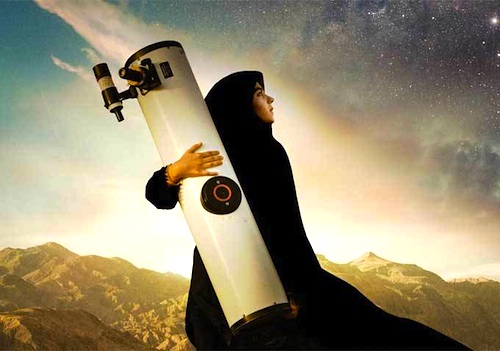By Joe Bendel. In the provincial Iranian foothills, an astronomy club sets up a portable telescope outside a skeletal observatory, abandoned halfway through the construction process. Meanwhile, it is full speed ahead for Iran’s nuclear reactors. Such are the scientific priorities in today’s Iran. For a teenage girl harboring astronomical dreams, the cultural climate is even trickier. Documentary filmmaker Berit Madsen quietly observes her subject plugging away in Sepideh Reaching for the Stars, which screens during this year’s Sundance Film Festival.
Star-gazing has profound personal significance for Sepideh Hooshyar. It is a form of meditation and a way to commune with the spirit of her beloved late father. As an intelligent student blessed with an independent streak, she has been tapped as a leader of her extracurricular astronomy club. Naturally, her patriarchal deadbeat uncles do not think very much of young women practicing astronomy. For reasons of greed and pettiness, they have jeopardized the financial position of Hooshyar’s mother. Still, the young woman is not inclined to kowtow to anybody.
While Hooshyar never directly addresses any political or ideological controversies, it would still be fair to describe her as a free-thinker. Throughout the film, she addresses her diary entries to her muse, Albert Einstein, and takes inspiration from her idol, Iranian American astronaut Anousheh Ansari (whom she erroneously considers the “first woman in space”).

Intellectually, most viewers understand Iran is far from a progressive society, but there are scenes of unabashed misogyny in Sepideh that will drop their jaws and boil their blood. Clearly, young Hooshyar is nearly always the smartest person in the room, but her government, society, and extended family all seem determined to squander her talents.
Given her fly-on-the-wall style, Madsen never offers any commentary or context, but it is transparently evident where these attitudes come from. The men and assorted female authority figures are all swimming in Islamist rhetoric. Filmed in a rather flat, colorless HD, Sepideh is not particularly cinematic looking, but there are real stakes to the drama that unfolds.
In many ways, Sepideh could be considered a fitting documentary companion to Haifaa Al Monsour’s narrative feature, Wadjda. It is a timely film, but also a deeply personal story. Highly recommended, Sepideh Reaching for the Stars screens again tomorrow (1/21), Thursday (1/23), and Friday (1/24) in Park City, as part of the 2014 Sundance Film Festival.
LFM GRADE: A-
Posted on January 20th, 2014 at 9:22pm.